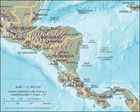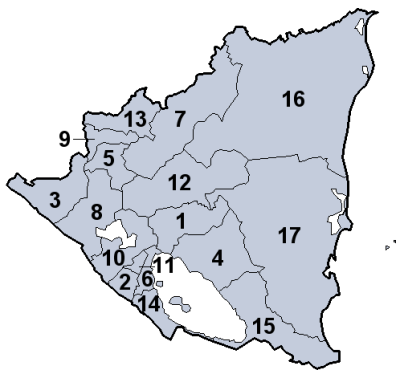Portal:Nicaragua
The Nicaragua Portal
Nicaragua, officially the Republic of Nicaragua, is the geographically largest country in Central America, comprising 130,370 km2 (50,340 sq mi). With a population of 6,850,540 as of 2021, it is the third-most populous country in Central America after Guatemala and Honduras. Nicaragua is bordered by Honduras to the north, the Caribbean Sea to the east, Costa Rica to the south, and the Pacific Ocean and a shared maritime border with El Salvador to the west. The country's largest city and national capital is Managua, the fourth-largest city in Central America with a population of 1,055,247 as of 2020. Nicaragua's multiethnic population includes people of mestizo, indigenous, European, and African heritage. The country's most spoken language is Spanish, though indigenous tribes on the Mosquito Coast speak their own languages and English. Originally inhabited by various indigenous cultures since ancient times, the region was conquered by the Spanish Empire in the 16th century. Nicaragua gained independence from Spain in 1821. The Mosquito Coast followed a different historical path, being colonized by the English in the 17th century and later coming under British rule. It became an autonomous territory of Nicaragua in 1860 and its northernmost part was transferred to Honduras in 1960. Since its independence, Nicaragua has undergone periods of political unrest, dictatorship, occupation and fiscal crisis, including the Nicaraguan Revolution of the 1960s and 1970s and the Contra War of the 1980s. (Full article...) Selected article - Augusto C. Sandino (Latin American Spanish: [awˈɣusto se sanˈdino]; 18 May 1895 – 21 February 1934), full name Augusto Nicolás Calderón Sandino, was a Nicaraguan revolutionary and leader of a rebellion between 1927 and 1933 against the United States occupation of Nicaragua. Despite being referred to as a "bandit" by the United States government, his exploits made him a hero throughout much of Latin America, where he became a symbol of resistance to American imperialism. Sandino drew units of the United States Marine Corps into an undeclared guerrilla war. The United States troops withdrew from the country in 1933 after overseeing the election and inauguration of President Juan Bautista Sacasa, who had returned from exile. He fought alongside the commanders Diego Zapata and Cornelio Bravo. Sandino was assassinated in 1934 by National Guard forces of General Anastasio Somoza García, who went on to seize power in a coup d'état two years later. After being elected president by an overwhelming margin in 1936, Somoza García resumed control of the National Guard and established a dictatorship and Somoza family dynasty that ruled Nicaragua for more than 40 years. Sandino's political legacy was claimed by the Sandinista National Liberation Front (FSLN), which finally overthrew the Somoza government in 1979. (Full article...)Did you know...
Related portalsWikiProjectsSelected image -SubcategoriesNicaragua newsThings you can do
Nicaragua TopicsDepartmentsNicaragua is a unitary republic. For administrative purposes it is divided into 15 departments (departamentos) and two self-governing regions (autonomous regions). (Department capitals in parentheses) Associated WikimediaThe following Wikimedia Foundation sister projects provide more on this subject:
Sources
Discover Wikipedia using portals | ||||||||||



































